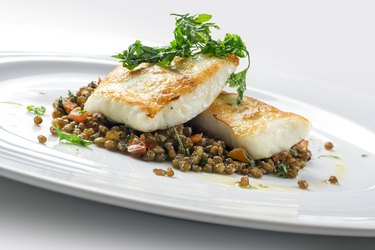
They're flat. They're slippery. Their beady eyes stare up at you from the fishmonger's cold case, seemingly reflecting their defeat at no longer swimming freely in the cold northern waters. Their loss is our gain, as sole fish in all its incarnations is one of the most delicate of white fishes and is in great demand by diners across the globe.
It was Dover sole that made Julia Child swoon as she savored her first taste of the delicacy upon arriving in France and set in motion the author's quest to conquer all foods French. Such is the hypnotic lure of a plate of simply prepared sole, expertly filleted, gently cooked and dressed in a delicate butter sauce.
Video of the Day
Video of the Day
Dover – The King of Sole
With over 500 species of flatfish swimming in waters around the globe, recognizing sole takes the expertise of a master fisherman. Eerie to behold, with both eyes bulging out of the right side of its body, we understand its evolution when we recognize that sole lives on the bottom of the sea and uses those eyes, which migrate to one side during its growing period, to protect itself from predators.
The deep, cold waters of the eastern Atlantic Ocean off the coast of Europe is home to most commercially sold Dover sole, featuring the flakiest meat, with a sweet taste yet low in oil. Fish labeled as sole that is fished from the northern Pacific Ocean off the coasts of California, Oregon, Washington and Alaska isn't really sole but is its kissing cousin, flounder.
The Sole vs. Flounder Discussion
The sole vs. flounder wars haven't made headlines, but a discerning diner and cook may look at the packaging of both fish as a commercial tease. Many fishes termed "sole" are actually flounder. They come from different families of fish, and while they appear similar in appearance and taste, when you order lemon sole, what you're really getting is a flounder so named because its shape resembles that of a lemon. The name has nothing to do with its inherent taste.
The same holds true for petrale sole, grey sole and lenguado. In fact, fish termed "sole" that is harvested in American waters is always flounder.
Shopping for Sole
When you approach the cold case at your local fishmonger's shop, the most obvious giveaway regarding the freshness of the catch is the smell of fish. If you can smell it, turn away and go elsewhere. The freshest fish, packed in ice, has no odor. The bulging eyes are bright and sparkling, and the gills are red or pink.
Most European markets tag the fish with the date and time of catch, the name of the fisherman and the waters from which it came. The more fish savvy we are when shopping for sole, the less likely we are to be sold sole that isn't actually sole. Always ask the seller where the fish was caught. That will tell you if the sole you're buying is actually flounder, halibut or turbot. All are flat fishes with similar taste profiles, but they're not sole.
Preparing Hypnotic Dover Sole
What was it about that Dover sole, served tableside at La Couronne restaurant in Rouen, France that sent Julia Child into a hypnotic trance? It was its simple preparation, which is how all delicate, white, flaky fish should be served. Lightly dusted in flour and then sauteed gently in butter, the sole is topped with a meuniere sauce made with butter, shallots, a dab of heavy cream and lemon juice. Seasoned with salt and pepper just before serving, Dover sole is truly the king of sole.